The History of Sangamo Electric Clocks
By Les McAlister
INTRODUCTION
Although much could be written about the Sangamo Electric Company, the purpose of this article is to focus on the years from 1919 to 1931. During this period, the Sangamo Electric Clock went from theory, to production, to the sale of all clock manufacturing operations. Before we do that, we should briefly cover how the Sangamo Electric Company came into being.
The year was 1896, in Springfield, Illinois, Ludwig Gutmann a German electrical engineer who held several patents for induction watthour meter designs was looking for a company to build his electrical meter. A patent lawyer introduced Gutmann to Jacob Bunn, Jr. who was the Vice President of the Illinois Watch Company. Because Gutmann’s design required a recording train, he believed that the watch company’s equipment would be ideal for manufacturing the meter. Bunn consulted with his father, Jacob Bunn, Sr., about the new project but the Senior Bunn rejected the venture and Bunn, Jr. decided to fund the initial production of two models on his own. Arrangements were made with the watch company to build the mechanical parts with Gutmann winding the coils, assembling and performing the testing. Because the watch company employed no one educated in electronics, in September 1897, Bunn hired Robert Lanphier a recent Yale graduate with a degree in electrical engineering. Lanphier worked with Gutmann in proving and perfecting the design over the next 12 months. In September of 1898 Bunn decided to proceed with the manufacture of the Gutmann Watthour Meter and an agreement was reached with the watch company for the use of a few machinists and the rental of vacant space. On January 11, 1899, the Sangamo Electric Company was formed with Jacob Bunn, Jr., his brother Henry Bunn and Ludwig Gutmann as officers.
How It All Began
Many business ventures begin by coincidence or chance and the Sangamo Electric Clock was no exception. In researching the history of Sangamo clocks, the period of early January 1919 is pivotal, for that is when Fred (Fritz) Holtz was hired as Chief Engineer of the Sangamo Electric Company. Fred was hired to replace Jacob Baird who died during the Influenza Pandemic of 1918. One of the first decisions Fred makes is to create a full fledged engineering department, which is not only responsible for the development of the Sangamo Electric Clock, but also the future success of the Sangamo Electric Company.
In 1921 Fred Holtz invents (and later receives a patent for) the “Holtz Patent” Type-A Induction-Reaction A/C motor. 
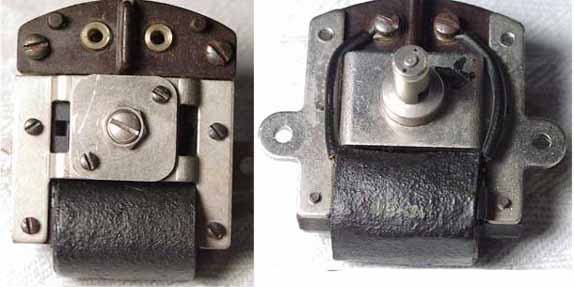 This motor was initially designed as an attachment in watthour meters to track demand, however, later is the key component in the Sangamo Electrically Wound Clock.
This motor was initially designed as an attachment in watthour meters to track demand, however, later is the key component in the Sangamo Electrically Wound Clock.
While traveling in Europe on a business trip in 1923, Fred first heard about new electric clocks being produced and thinks of using the Type “A” motor to wind the mainspring in a clock. On returning to the states in 1924, he discusses this idea with Mr. Bunn and Mr. Lanphier who authorize him to build models for testing, using movements manufactured by the Watch Company. During the latter part of 1924 “some forty” time only experimental clocks tested performed so well that a decision was made to proceed in tooling up for clock production.
Why A Sangamo Electrically Wound Clock
Before one can understand the Sangamo movement’s design, one must first understand the state of electric power supply in the early 1920s. The use of electricity was spreading throughout America, but it was very unreliable. Power might be on for one hour and then off for two and fluctuations in frequency and voltage made synchronous electric clocks inaccurate. The Sangamo Electric Clock overcame all these obstacles as it only used electricity to wind a mainspring, which could power the clock for 24 hours if the power failed. In this configuration neither power interruptions nor variations in frequency or voltage had any direct impact on timekeeping. With the Sangamo Electric Company operating from rented property on the grounds of the Illinois Watch Company and their relationship (both personal and business) to the watch company, the idea to use a precision jeweled lever escapement as the heart of the movement made perfect sense. Not only could they help support sales for the watch company, but they could use the reputation of Illinois Watches to bolster the image of their clocks. Truly a match made in heaven!
A Clock is Born
As noted previously, the first experimental movements were designed by Sangamo, but hand-built by the Illinois Watch Company. Only 2 of the original “some forty” experimental movements are known to have survived, #27 and #46, which bore little resemblance to the original Holtz patent
and #46, which bore little resemblance to the original Holtz patent To understand the original design of the movement we need to separate it into 3 sections, winding train, time train and platform.
To understand the original design of the movement we need to separate it into 3 sections, winding train, time train and platform.
1. The winding train consists of a Type-A, inductive motor, 3 wheels and a 4th wheel, which is mounted onto the winding shaft of the mainspring assembly. There is also a safety pawl that ratchets on the 4th wheel when winding, but locks the wheel to keep the mainspring from unwinding through the motor if the power fails. When current is supplied to the motor, motion travels through the gear train to the 4th wheel on the winding arbor of the mainspring assembly. Once the mainspring is wound sufficiently, the spring tension overcomes the torque of the motor, stalling it. The mainspring barrel then supplies power through the time train to the platform at a constant and controlled rate. As the mainspring unwinds, the torque of the motor overcomes the spring tension and winds the mainspring back to optimal levels. If the power failed, the mainspring continues to supply power to the platform for up to 24 hours. Once power was restored, the mainspring would wind back to the optimal level.
2. The time train also used 3 wheels, with the first wheel driven by the mainspring barrel and the 3rd wheel driving the platform escapement. The 2nd wheel extends through the front plate and carries the dial train.
3. The 11-jewel platform (SN #39) custom made by the watch company uses an Illinois Watch 16 size balance assembly and is mounted on the back of the movement providing precision timekeeping.
One can only imagine how excited Sangamo must have been to have invented this clock. In fact Robert Lanphier later wrote that all other projects were canceled due to the drain on capital caused by gearing up for clock production. They jumped in with both feet!
Nothing but the Best
From the beginning, it seems that Sangamo had only one thing in mind and that was to be the best in both quality and accuracy, sparing no expense. Clock production began in the spring of 1926, the first of which were time-only. An article in the Springfield Journal dated 8/3/1926 gave a description of the clocks and announced that they would be on sale to the public in just a few months. The first production movements used the same winding design, with the mainspring stalling the motor. The platform was moved to the front of the movement and we see the first use of the round Illinois 11-jewel double roller, damascened platforms. The plates were now round, nickel plated, beautifully damasked and incredibly all gears were gold plated. These movements were in effect giant, high grade, electrically wound Illinois pocket watches. In fact, the following description was printed in the original 1926 Catalog:
used the same winding design, with the mainspring stalling the motor. The platform was moved to the front of the movement and we see the first use of the round Illinois 11-jewel double roller, damascened platforms. The plates were now round, nickel plated, beautifully damasked and incredibly all gears were gold plated. These movements were in effect giant, high grade, electrically wound Illinois pocket watches. In fact, the following description was printed in the original 1926 Catalog:
The eleven-jeweled double roller escapement in the Sangamo Clock is made by the Illinois Watch Company, famous for nearly sixty years for fine watch movements, and is of the same general construction and quality as used in the finest Illinois pocket time-pieces. This escapement, with its compensating balance, was designed especially for the Sangamo Clock as an enclosed replaceable unit, so as to give perfect interchangeability. With an escapement of highest quality, on which the accuracy of any time-piece depends, with constant torque from the main spring, and the highest quality of construction throughout the movement, it is not surprising that the Sangamo Clock gives an accuracy far beyond that attained in previous clocks, in fact, the time-keeping quality of the Sangamo Clock are equal to those of the finest railroad watches – guaranteed, after proper adjustment, to maintain an accuracy within thirty seconds per week.
If no expense was spared in the construction of the movements, the same can be said of the cases. Sangamo offered several different styles of mantel clocks made in either mahogany or walnut  and even a cast bronze model case made by Gorham.
and even a cast bronze model case made by Gorham.  They also offered 2 styles of wall clocks
They also offered 2 styles of wall clocks
 which were made of cast aluminum and could be finished in black or white enamel as well as simulated wood grain. The following was written in the 1926 catalog about the cases:
which were made of cast aluminum and could be finished in black or white enamel as well as simulated wood grain. The following was written in the 1926 catalog about the cases:
The movement of all Sangamo Clocks is supported from the front of the case, a construction which permits all cases to be made with solid back, thus preventing the entrance of dust or dirt, and tampering with the movement by unauthorized or curious persons. The complete enclosure of the movement renders it unnecessary, under ordinary conditions, to inspect and oil a Sangamo Clock at intervals of less than two years. The movement is attached to four brass plates, permanently fastened to the case, and the dial is similarly held on four smaller plates, ensuring absolute uniformity of position for movement and dial.
The bezel ring carrying the dial glass, and its base plate, on all Sangamo Clocks, are turned from solid brass, fastened together with a small but strong hinge, and so accurately made that the bezel snaps tight on the base ring without any latching device. Bezel rings on all mantel clocks are heavily gold plated.
Sangamo Clocks are supplied in a wide variety of handsome cases, in mahogany, walnut and cast bronze, for mantel clocks, while the cases of wall clocks are cast aluminum, finished in black and white enamel, and in wood effects.
The 1927 Catalog introduced a new line of clocks, which were now not only available with hour and half-hour strike, but in a new case designs “In the Style of the Best Early Masters.” These case designs were reproductions of English and early American clocks, made specifically for Sangamo by Erskine-Danforth, considered one of the top furniture manufacturers (Danersk Furniture) of that time. These were the first Sangamo clocks to actually have a name and not just a model number. They were the Old Salem Act of Parliament
Act of Parliament  Roxbury
Roxbury and Sudbury Grandfather Clock
and Sudbury Grandfather Clock The following description of these clocks was written in the 1927 Catalog:
The following description of these clocks was written in the 1927 Catalog:
CLOCK-CASE making was at its height in the Golden Age of Furniture. Sheraton and Chippendale, Heppelwhite and the Brothers Adam established n the eighteenth century an English tradition of cabinet-making that has never been surpassed. In harmony with them worked the best clockmakers of London Town.
About the middle of the eighteenth century the artisan class in England became discontented with the conditions under which they worked, and crossed the water. Some of the most skillful of the English clockmakers settled in Massachusetts and Connecticut. The three Willards of Roxbury were famous. David Wood’s Old Salem Clock is a fine example of that time. Could you find an original today, collectors would cheerfully pay thousands of dollars for the case alone. Poets in mahogany, these early clock-case makers built fine and beautiful things that have stood the test of centuries. Nowhere else could Sangamo find better models for the cases in which to house the Sangamo Electrically Wound Clock.
Some of the most famous of these English and early American clock cases have been exactly reproduced. The actual cabinet making is done by the makers of Danersk Furniture, the Erskine-Danforth Corporation, whose New England workmen have for many years carried on the finest tradition of English and American furniture making. All the delicacy of detail in the originals is faithfully followed…the mouldings are slim, the backs of feet and overhanging ornaments are chamfered to give the proper thinness of outline, the joinery is done with all the care of old-time craftsmen. The grain of rare woods is used with decorative effect…burled walnut, full of silvery swirls like moiré silk…crotch mahogany, rubbed to dusky richness…smooth surfaces lacquered dull black and ornamented with golden scrolls. The bronze designs similarly follow the best historic precedent, and are the creation of the Gorham Company.
These clocks were truly the best of the best and held a price tag to match. The Sudbury Grandfather Clock was the most expensive, with a suggested retail price for the striking model of $400 ($4,400 in 2006 dollars) and the least expensive was the Ellsworth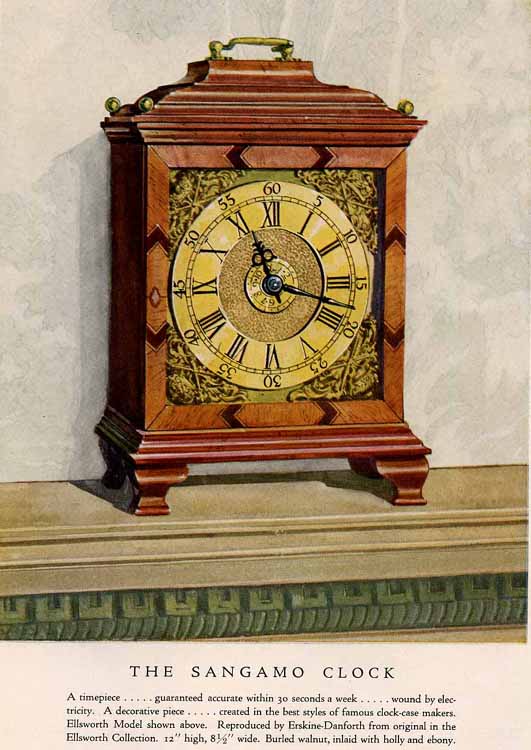 (first appearing in the 1928 “Green” catalog) at $175 ($1,900 in 2006 dollars). In fact, the exceptional quality of these cases was the cause of their downfall, as many cases were converted from Sangamo Electric movements to old spring or weight driven movements by enterprising Antique Dealers. This is especially true of the full-size Sangamo banjo clocks
(first appearing in the 1928 “Green” catalog) at $175 ($1,900 in 2006 dollars). In fact, the exceptional quality of these cases was the cause of their downfall, as many cases were converted from Sangamo Electric movements to old spring or weight driven movements by enterprising Antique Dealers. This is especially true of the full-size Sangamo banjo clocks whose cases are virtually identical to Waltham, who is also believed to have made them for Sangamo.
whose cases are virtually identical to Waltham, who is also believed to have made them for Sangamo.
Spreading the Word
To introduce these new clocks to the trade and public, Sangamo entered into what must have been a very expensive advertising campaign in 1927. Considering the fact that their least expensive mantel clock in the 1926 Catalog was $60 (over $660 in 2006 dollars), they had to appeal to people in higher income brackets, which is exactly what their advertising attempted to do. Full page color advertisements such as the ones shown below
 have been found in all major publications of the day (Time, Better Homes and Gardens, National Geographic, etc.). The ads promote the convenience of “Electric Wind” and accuracy of “Railroad Time”, as well as the fine collector’s cases. Statements such as “A clock that acts as a Master Clock for all other clocks in the household”, “A clock as accurate as a railroad watch” and “1927’s gift for people who have everything“, stress quality and accuracy. Sangamo also touted their “3-POINT GUARANTEE”, which was:
have been found in all major publications of the day (Time, Better Homes and Gardens, National Geographic, etc.). The ads promote the convenience of “Electric Wind” and accuracy of “Railroad Time”, as well as the fine collector’s cases. Statements such as “A clock that acts as a Master Clock for all other clocks in the household”, “A clock as accurate as a railroad watch” and “1927’s gift for people who have everything“, stress quality and accuracy. Sangamo also touted their “3-POINT GUARANTEE”, which was:
1. Accuracy within 30 seconds a week.
2. Continued operation through all current interruptions up to 24 hours.
3. Parts warranted for 2 years.
This guarantee addressed all the potential downfalls of an “electric” clock in the 1920s. Accuracy was very important as synchronous electric clocks made during that time were notoriously poor timekeepers. Continued operation through current interruptions was also important, as electricity was unreliable during this time. This was a major fault with manual starting synchronous clocks that needed to be restarted and reset after every current interruption. The 2 year parts warranty was Sangamo’s way of making a bold statement about their confidence in The Sangamo Clock’s quality and reliability. In a time where the one year warranty was standard, a two year warranty basically said that, “we are twice as good,” again reinforcing their brand image.
Sometimes Things don’t go as Planned
Before we go much further, I should give you a better idea of the history of the Sangamo Electric Company. True to the entrepreneurial sprit of their President, Jacob Bunn, if an idea sounded as if it had merit, Mr. Bunn would approve experimentation. This led to such things as the Springfield Refrigeration Company (formed in 1915, folded in 1919), The Economy Electric Devices Company (formed in 1917, given to investors a few years later) and The Pressley Radio Kit (formed 9/1924 folded 1/1925 due to RCA patent infringement.) The history of the company shows a bold pioneer spirit, but sometimes it seemed that in their enthusiasm, they missed the obvious. Such was the case in the original design of the Sangamo electrically wound movement.
As stated at the beginning of this article, the original design called for the motor to wind the mainspring until the wound resistance of the mainspring overcame the torque of the motor, stalling it. For some reason the engineers failed to detect a design flaw, which was the effect that voltage fluctuations would have on the motor. As noted before, power grids at this time suffered from inconsistencies in both current and frequency. Because Sangamo was an electric meter company, they likely had a very finely regulated electrical supply under which the clocks were tested. Frequency, which affects the speed of an A/C motor, has no effect on a Sangamo clock. The motor merely winds the mainspring, the speed of which has nothing to do with timekeeping. Excessive voltage, however, increased the torque of the motor and caused the motor to over wind the mainspring, which in turn caused the platform to speed up and/or over bank, greatly impacting timekeeping. The power grids outside Springfield were, likely, not as precisely regulated as electricity was mostly used for lighting purposes. Once these clocks were outside the Springfield electrical system, it must not have taken long before the design flaw manifested itself and the complaints rolled in
The engineers probably discovered the problem quickly and implemented a production change. On December 16, 1930, U.S. Patent #1,785,301 was granted to Mr. Charles E. DeLong for a mainspring brake mechanism to regulate the winding of a mainspring in an electrically wound clock movement. The Patent Application was originally filed on October 4, 1926; just a few short months after clock production began. The new brake system incorporated a threaded collar that screwed into the mainspring housing as the mainspring was wound by the motor. A metal arm with an adjustable brake rod was mounted at one end on a post, which allowed the arm to move up and down. This arm passed over the 1st wheel on the winding train and the brake rod was positioned in the arm directly above the face of this wheel. The other end of the arm is formed in a “U” shape and sits inside the collar on the mainspring barrel. As the motor winds the mainspring, the collar is gradually drawn into the mainspring housing. The end of the brake arm sitting inside the collar moves downward with it, lowering the brake rod until it contacts the face of the 1st wheel and “brakes” the winding train. By adjusting the brake rod up or down, a precision adjustment could be made limiting the winding of the mainspring. As the mainspring wound down, the collar would move out and allow the arm to release the brake rod and the motor to wind the mainspring back to the same position. When the system was in perfect working order, the brake would let off just enough to allow the motor to wind the mainspring as the clock ran, achieving the ideal in clockmaking of constant and controlled power. Only three of the early round damasked movements without the brake system are known to have survived in unaltered condition, all with serial numbers less than 100. It is believed that Sangamo issued a service bulletin (although a copy has not been located) and parts to install the mainspring brake system on clocks that had already been shipped or sold. With the new braking system it was impossible for the mainspring to over wind, making it the perfect system for controlling mainspring power…. or so they must have thought.
was granted to Mr. Charles E. DeLong for a mainspring brake mechanism to regulate the winding of a mainspring in an electrically wound clock movement. The Patent Application was originally filed on October 4, 1926; just a few short months after clock production began. The new brake system incorporated a threaded collar that screwed into the mainspring housing as the mainspring was wound by the motor. A metal arm with an adjustable brake rod was mounted at one end on a post, which allowed the arm to move up and down. This arm passed over the 1st wheel on the winding train and the brake rod was positioned in the arm directly above the face of this wheel. The other end of the arm is formed in a “U” shape and sits inside the collar on the mainspring barrel. As the motor winds the mainspring, the collar is gradually drawn into the mainspring housing. The end of the brake arm sitting inside the collar moves downward with it, lowering the brake rod until it contacts the face of the 1st wheel and “brakes” the winding train. By adjusting the brake rod up or down, a precision adjustment could be made limiting the winding of the mainspring. As the mainspring wound down, the collar would move out and allow the arm to release the brake rod and the motor to wind the mainspring back to the same position. When the system was in perfect working order, the brake would let off just enough to allow the motor to wind the mainspring as the clock ran, achieving the ideal in clockmaking of constant and controlled power. Only three of the early round damasked movements without the brake system are known to have survived in unaltered condition, all with serial numbers less than 100. It is believed that Sangamo issued a service bulletin (although a copy has not been located) and parts to install the mainspring brake system on clocks that had already been shipped or sold. With the new braking system it was impossible for the mainspring to over wind, making it the perfect system for controlling mainspring power…. or so they must have thought.
The Illinois Watch Company Connection
As noted earlier in this article, the Sangamo Electric Company was started in buildings rented from the Illinois Watch Company, who’s President, Jacob Bunn Sr., was father to Jacob Bunn Jr., President of Sangamo. Research has shown that this close proximity was a great help to Sangamo in the beginning, as Illinois Watch Company resources were “borrowed” by Sangamo to help start up meter production. In fact the Sangamo oval logo was created by Grandville Kindred, the head engraver of the Illinois Watch Company at the time. He suggested to Robert Lanphier that the letters in the name Sangamo be given a “wiggle” to make them look as if lightning had hit them, since Sangamo was the manufacturer electrical devices. He then skillfully sketched the design which was immediately approved and adopted.
was created by Grandville Kindred, the head engraver of the Illinois Watch Company at the time. He suggested to Robert Lanphier that the letters in the name Sangamo be given a “wiggle” to make them look as if lightning had hit them, since Sangamo was the manufacturer electrical devices. He then skillfully sketched the design which was immediately approved and adopted.
One could easily say that without the strong influence of the Illinois Watch Company, the Sangamo Electric Clock would have never been made. The availability of highly trained craftsmen in the same complex, with an extensive background in the manufacturing of fine timepieces, was surely a great help in the development of these outstanding clocks. Not only did the watch company custom build the first platforms for the experimental movements but later the high grade 11-jewel, 16-Size Illinois balance platforms
but later the high grade 11-jewel, 16-Size Illinois balance platforms  were a key selling feature of the clock. In fact, Sangamo was so eager to show off the Illinois escapement in their clocks, that they offered an optional dial where the platform could be seen at work through a viewing window
were a key selling feature of the clock. In fact, Sangamo was so eager to show off the Illinois escapement in their clocks, that they offered an optional dial where the platform could be seen at work through a viewing window These “visible escapement” dials were only offered on 11-jewel Illinois escapement clocks, which were considered their top of the line models.
These “visible escapement” dials were only offered on 11-jewel Illinois escapement clocks, which were considered their top of the line models.
Nothing but the Best Can Be Too Expensive
The clockmaking industry was very competitive in the 1920’s and Sangamo being the new kid on the block, had to not only establish a foothold in the market, but get customers to buy their expensive new product. When you consider that Sangamo had to target the upper class, their market was quite small. In order to compete in the middle class and sell in volume, they had to find a way to reduce costs.
Late in 1927 Sangamo began the production of a new less expensive 7-jewel Series of clocks. These clocks used a round 7-jewel, Illinois platform of good quality, but without the beautiful plating and damasking. The clock movements and motors were the same as the 11-jewel models, however, were not as highly finished, lacking gold plating on the gears. The time-only movement plates were still nickel plated, but were no longer damasked and the nickel on time/strike plates was no longer brushed. The clock cases themselves were still of very high quality, however, the bezel was now made of spun brass with a regular glass, instead of the cast brass, gold plated bezel with beveled glass that was used only on the Eleven Series clocks. By doing this they were able to reduce the sale price of an 11-jewel clock by half, with comparable tambour models falling from $80 to $40. The 1928 “Green” Catalog is the first to mention the change, announcing the new Sangamo Eleven and Sangamo Seven Series of clocks. The following is an excerpt from that catalog:
In timekeeping accuracy and general performance these clocks are entirely comparable with the clocks of the “11” series. Except under very wide variations in temperature, not ordinarily experienced in service, they can be relied upon to mark the time with railroad watch accuracy. We offer and recommend them to you with the assurance that no clocks, whether hand wound or electrically wound, whether with pendulum or lever escapement, can offer you the equal convenience, timekeeping qualities, dependability and appearance at a price anywhere near that of a Sangamo “7”.
Sangamo began an extensive advertising campaign announcing the new “popular-priced” Sangamo Seven Series  Now everyone could afford to have the quality and accuracy of a Sangamo Electrically Wound clock. They even advertised a new Sangamo Clock Club
Now everyone could afford to have the quality and accuracy of a Sangamo Electrically Wound clock. They even advertised a new Sangamo Clock Club where people could enroll for only $5, take the clock home and “Then pay the balance in easy payments – so small that you’ll never miss them.” I am sure that everything went as planned and sales of the new Sangamo Seven Clocks skyrocketed. What I am not sure of is how long it took someone at Sangamo to realize that there was a problem with this marketing concept.
where people could enroll for only $5, take the clock home and “Then pay the balance in easy payments – so small that you’ll never miss them.” I am sure that everything went as planned and sales of the new Sangamo Seven Clocks skyrocketed. What I am not sure of is how long it took someone at Sangamo to realize that there was a problem with this marketing concept.
Good Old Fashioned American Ingenuity
One question that had always bothered me was, “Why did Sangamo quit using a round 7-jewel Illinois platform and switch to an oval 7-jewel Illinois model in early 1928?” One could argue that it was a less expensive design that reduced cost, but the expense of changing the tooling would have far outweighed any savings that could have been made from this modification. The round 11-jewel platform was still in use on the Sangamo Eleven series, so why didn’t they change that to an oval design also? It just didn’t make sense.
Over the years I have purchased many Sangamo clocks and movements and began to notice something peculiar. I acquired several early Seven Series clocks, which should have had round 7-jewel Illinois platforms, but instead had round 11-jewel Illinois platforms. The first few I discounted as replaced to address a customer complaint or because it was all the repairperson had on hand to use, but then two or three more popped up. Why would someone put a more expensive 11-jewel platform in a less expensive Seven Series case and movement? Then I remembered that the Seven Series clocks were half the price of the Eleven Series and the answer came to me. It must not have taken long for enterprising Jewelers to figure out that if they purchased the less expensive 7-jewel clock and then replaced the 7-jewel platform with an 11-jewel platform, they could charge the 11-jewel sales price at a 7-jewel cost structure. How long it took Sangamo to figure out what was going on is not clear. I would speculate that when spare parts sales of the 11-jewel platforms shot through the roof and Eleven Series sales bottomed, it didn’t take long for them to realize the mistake they had made.
The “Green” 1928 Sangamo catalog is the first to mention the “oval” 7-jewel Illinois platform, so the change from round to oval must have happened in a relatively short period of time. Since only an oval 7-jewel platform would fit on a Seven Series movement, counterfeit Eleven Series clocks could no longer be made, securing their advertising strategy. Luckily for Sangamo, there were several other design changes on the drawing board, which also needed to be put into production.
Interestingly enough, some time/strike movements with early serial numbers (55XX) have been found that use a rectangular 7-jewel Swiss platform.  This configuration is very rare and the movements are always finished in a lower quality, some with no nickel plating at all. Early Sangamo Salesman’s Samples have been found with this platform displayed.
This configuration is very rare and the movements are always finished in a lower quality, some with no nickel plating at all. Early Sangamo Salesman’s Samples have been found with this platform displayed.  (Figure 22) No documentation has been discovered that sheds any light on their application, although it is assumed that this was Sangamo’s earliest attempt at cost reduction. Experimentation with this platform was likely conducted early on and then discontinued in favor of the round 7-jewel Illinois platform, which (as this writer can attest) is a much better timekeeper.
(Figure 22) No documentation has been discovered that sheds any light on their application, although it is assumed that this was Sangamo’s earliest attempt at cost reduction. Experimentation with this platform was likely conducted early on and then discontinued in favor of the round 7-jewel Illinois platform, which (as this writer can attest) is a much better timekeeper.
New and Improved
As would be expected, several operational problems with movements were discovered after the first few years of service that called for design changes. The first major changes were put into production in early 1928 with the introduction of what is referred to as the Type-L movements. 

 This new design incorporated several improvements:
This new design incorporated several improvements:
1. A new stronger inductive motor (Type-B) was introduced
having sufficient torque to wind a stronger mainspring, which in turn allowed one mainspring to power both the time and strike through a differential setup. This eliminated the need for two motors on the time/strike models, but increased the demand on the mainspring braking system. This differential also allowed the clock to strike when the power was off, where the previous model would not.
2. A new mainspring brake system was introduced, which used a 1mm ball bearing located inside a cup mounted in front of the lower 1st winding wheel pivot. This bearing rested on the nose of the 1st wheel pivot and not only reduced friction and wear to the bearing surfaces, but also maintained consistent positioning of the winding wheel as the brake was being applied to its face. Although this system corrected several inherent problems with the old mainspring brake system, it created a service problem as many Clock Repairmen (not realizing it was there) lost the bearing during servicing. Without this ball bearing in place the mainspring brake system was rendered virtually useless and many clocks are found with this problem today.
3. Another needed improvement was a device that allowed the hour hand to be moved “backwards” through the 12-O’Clock position on striking models. If this were attempted on prior models the hour hand would likely be bent and if attempted too forcefully, the lifting lever would be damaged.
4. A new “split” back plate that allowed easier servicing of the movement. With this new design, a Clock Repairman could access the gears of the strike train without disturbing the time or winding train.
5. Sangamo also redesigned the strike train in a way that has baffled many Clock Repairmen. Unlike any other clock, the Type-L strike train is designed so that when it is a rest, the followers for both strike hammers are positioned on top of the lifting pins in the full “raised” position. This was done to allow a “blocking” lever to move into position before the half-hour, only allowing one of the strike hammers to fall on a chime rod on the half hour strike. As time progressed towards the hour, this “blocking” lever would move out of the way and let both hammers fall, counting the hour. With this system you could have the harmony of two hammers hitting two chime rods on the hour and only one on the half-hour. If you know how the strike train works and have the proper tool, synchronizing is easy. If not, it will drive you crazy with an extra chime (about 15 minutes before the hour) as the lever falls away and lets the hammer, which had been held up during the half-hour strike, fall.
6. The introduction of a new 7-jewel OVAL platform. Now the less expensive 7-jewel series clocks/movements would only accept the 7-jewel oval platforms, with use of the round Illinois 11-jewel platforms reserved for expensive Eleven Series models. Later in the Hamilton-Sangamo years, they must have run out of round 11-Jewel Illinois platforms. Since Hamilton had purchased the Illinois Watch Company and was no longer making the “round” 11-jewel Illinois platforms, it became necessary for Hamilton to convert some 7-jewel platforms to 11-jewel. In rare cases these can be found today where the number “7” in the “7-jewel” stamped into these platforms is over-stamped with “11”
and additional jewels added to the escape wheel and pallet fork pivots. These platforms are very plain with no damasking and found mostly on timers. Later it was necessary for Sangamo to convert Eleven Series Hamilton-Sangamo Jeweler’s Regulator wall clocks to use an oval platform. These beautiful oval platforms are 11-jewel, marked Hamilton and are very well made and highly damasked.
These improvements were the last made to Sangamo electrically wound movements and they remained basically unchanged through the end of clock production in 1931.
Time to Join Forces, Hamilton-Sangamo
Early in 1928 the Hamilton Watch Company purchased the Illinois Watch Company, ending an era in Springfield, Illinois history. We can only assume how traumatic this must have been for the employees, but with the Sangamo Electric Company located in virtually the same complex, the situation must have been uneasy at best. We can also assume that Sangamo must have stockpiled as many Illinois platforms as possible to ensure that clock production would continue if a working business relationship with Hamilton could not be established.
In September of 1928 Hamilton President, Charles Miller, suggested that Hamilton and Sangamo join forces in the electric clock business. The idea was for Sangamo to continue manufacturing clocks with Hamilton supplying platforms and sales expertise. This offer must have been very attractive to Sangamo because they had expended a great deal of money in advertising their clocks to the trade and public. It also gave Sangamo access to Hamilton sales outlets and sales force, not to mention eliminated the cost of purchasing platforms from Hamilton. Because they didn’t manufacture clocks, the advantage to Hamilton was also clear. This opened new markets for them in the booming electric clock business with little investment. Negotiations must have proceeded quickly, as an article in the Springfield Journal dated 5/5/1929 announced the Hamilton-Sangamo merger. The Hamilton-Sangamo Corporation was organized on 6/1/1929 equally owned by both companies.
It is important to note two common misconceptions about the Hamilton-Sangamo merger:
Hamilton did not “buy-out” Sangamo, they merely joined forces to form a corporation equally owned by both.
There was never a Sangamo Clock Company. The Sangamo Electric Company made clocks, electric meters, capacitors, timers, Tachographs, as well as other electric instruments. The parent corporations remained independent entities.
Timing is Everything
In business, having the right product at the right time with the right marketing can take a company to new heights. Unfortunately, the opposite can be said if you have the wrong product in a changing market. Such was the case with the Hamilton-Sangamo clock, as only 5 short months after the Hamilton-Sangamo Corporation was formed, a momentous event was to occur. On Thursday, October 29, 1929 the Stock Market crashed and The Great Depression began, not fully ending until the start of WWII. It doesn’t take much imagination to see how this would affect a company who was selling the most expensive clock in an industry whose product was a “discretionary” purchase. Not only that, but much less expensive synchronous clocks were increasing in popularity as the reliability of the power grid and stability of 60 cycle current improved dramatically.
To counter this trend, Sangamo developed the Type-E, non-self-starting synchronous motor.  The new synchronous motor driven movement was unlike other clocks on the market because instead of having a sweep second hand, it utilized a seconds “disc” which revolved in the center of the dial. This movement was installed in an all new line of high quality cases
The new synchronous motor driven movement was unlike other clocks on the market because instead of having a sweep second hand, it utilized a seconds “disc” which revolved in the center of the dial. This movement was installed in an all new line of high quality cases and went on sale in October of 1930. The least expensive Hamilton-Sangamo synchronous clock had a suggested retail price of $10.00, with the most expensive $30.00, which was still a high price to pay.
and went on sale in October of 1930. The least expensive Hamilton-Sangamo synchronous clock had a suggested retail price of $10.00, with the most expensive $30.00, which was still a high price to pay.
Unfortunately Sangamo’s timing was still off. As they launched their non-self-starting line of clocks, other makers came out with new self-starting models. The non-self-starting models needed to be manually restarted after any power failure, but the self-starting clocks began working again as soon as power was restored. Sangamo engineers quickly went to work and developed the Type-F self-starting synchronous motor  and in December of 1930 were preparing to launch a new line of clocks incorporating this motor.
and in December of 1930 were preparing to launch a new line of clocks incorporating this motor.
Time to Cash It In
Just as Sangamo was getting ready to launch the new line of self-starting clocks for Hamilton-Sangamo, they were approached by the General Time and Instruments Corporation, makers of Big Ben and Seth Thomas clocks. GTI expressed an interest in purchasing the Type-F synchronous motor from The Sangamo Electric Company for use in their electric clocks. Since Sangamo’s contractual agreement with Hamilton-Sangamo only allowed them to sell motors and movements to Hamilton-Sangamo, the offer was declined. At this point, Ralph Matthiessen, President of GTI offered to purchase the Hamilton-Sangamo Corporation and thereby obtain exclusive rights to Sangamo electric motors for clock purposes. I am sure that this offer was greeted enthusiastically by both Hamilton and Sangamo, as any opportunity to recover cash from a losing venture in the days of The Depression would have been welcomed. An agreement was reached in April of 1931 for the sale of the Hamilton-Sangamo Corporation to GTI. The Sangamo Electric Company retired from the clockmaking business and as Robert Lanphier later wrote “at considerable loss, but with much valuable experience.”
An article in the Springfield Journal dated 5/15/1931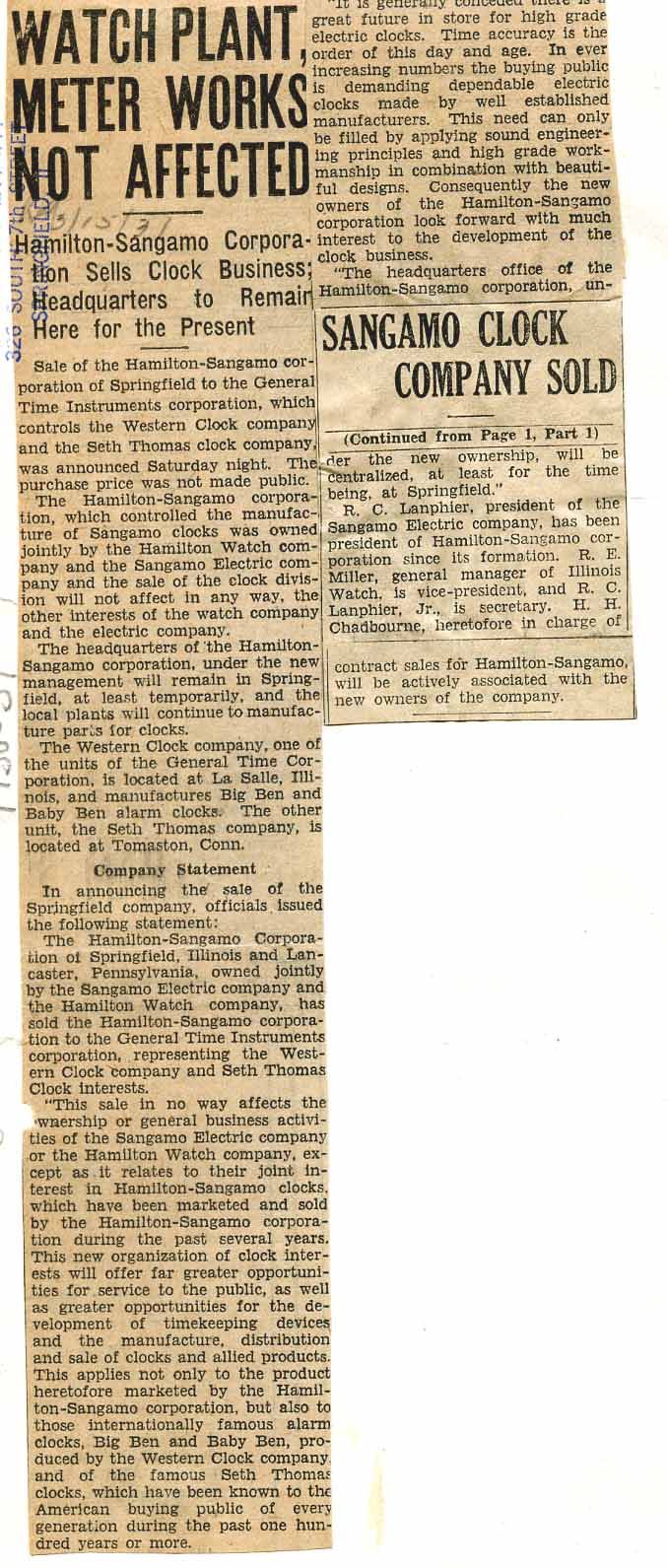 announced the sale of Hamilton-Sangamo to GTI, but also mentioned that operations would remain in Springfield “for the time being” and that “production would continue four days a week.” It is assumed that GTI kept operations in Springfield for only a few months until the inventory of Hamilton-Sangamo labeled clocks were depleted.
announced the sale of Hamilton-Sangamo to GTI, but also mentioned that operations would remain in Springfield “for the time being” and that “production would continue four days a week.” It is assumed that GTI kept operations in Springfield for only a few months until the inventory of Hamilton-Sangamo labeled clocks were depleted.
Time Marches On
It is unfortunate that Sangamo and Hamilton-Sangamo Electric clocks were only manufactured for five short years (spring of 1926 to 4/1931) and synchronous models with Hamilton-Sangamo dials, made only nine months (8/1930 to 4/1931). In this writer’s opinion, these clocks are the highest quality electric clocks ever manufactured. The 11-jewel electrically wound movements are the most beautiful and well made I have ever seen in a clock case, with no expense spared. It is a shame to hide these exceptionally finished, giant high-grade pocket watches behind a dial, even if they were housed in some of the best and most expensive cases made.
We know that Sangamo kept exact records of production dates and serial numbers, but none of this information is known to have survived. Furthermore, no platform production records from either the Illinois Watch Company or Hamilton Watch Company have been located. It is impossible to date Sangamo clocks by their serial number, because this system appears to be erratic. That said, ID Tags mounted on the back of every Sangamo clock are the best way to establish approximate dates of manufacture as follows:
If the ID tag has the name “Sangamo Clock”
at the top, it was made sometime between the spring of 1926 and June of 1929 before Sangamo went into business with Hamilton.
If the ID tag has “Hamilton-Sangamo”
at the top and has both the Lancaster and Springfield addresses, it was manufactured somewhere between June of 1929 and April of 1931 before GTI took control.
After GTI purchased Hamilton-Sangamo, they changed the information on ID tags, removing the city of Lancaster, PENN (the home of Hamilton), only listing city of Springfield, ILL.
The dials on these clocks were also changed, with the Hamilton-Sangamo logo replaced with the name “Sangamo” in block letters.
Clocks with this tag were built after April 1931.
After moving operations to Thomaston, GTI launched several new styles of Sangamo synchronous clocks. These clocks can be identified by ID tags which list the name Sangamo and only have the Thomaston, CONN address.
Clocks with this tag were no longer built in Springfield, Illinois and no date for this change has ever been confirmed.
The Sangamo Clock Legacy
While it is true that the Sangamo Electric Company no longer made and sold clocks after the GTI purchase, they remained very active in the area of timekeeping and benefited greatly from their clockmaking experience. For many years Sangamo continued to manufacture electrical timers for commercial use, including an electrically wound precision 11-jewel timer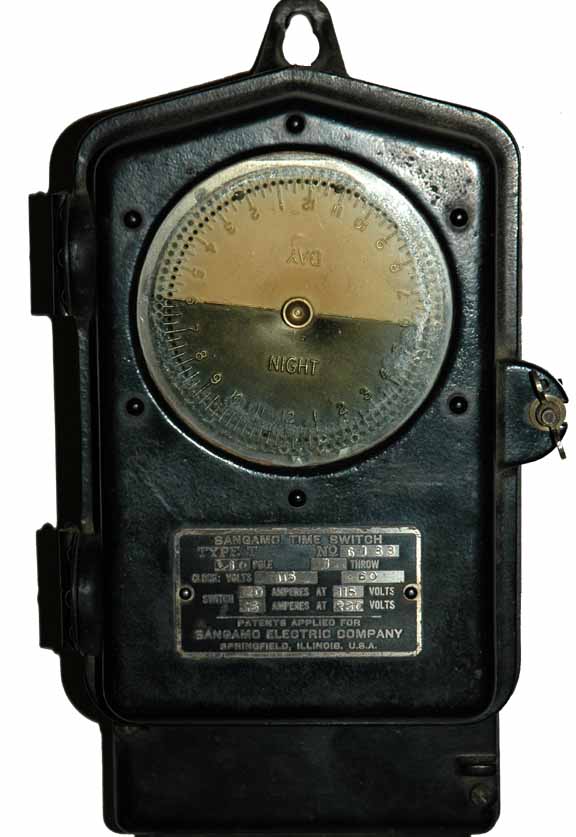 based on their time/strike clock movement. Also using a clock movement, Sangamo made the Tachograph,
based on their time/strike clock movement. Also using a clock movement, Sangamo made the Tachograph, 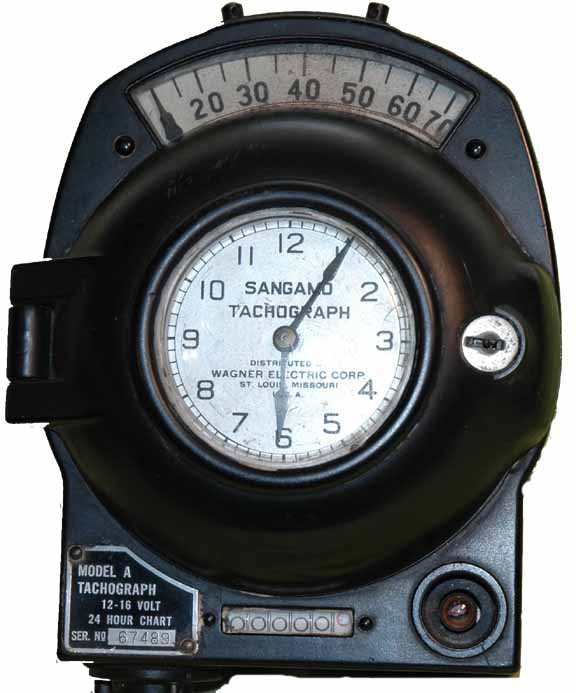 a device mounted in trucks that charted driving speeds and times so companies could monitor drivers’ activities. In fact their reputation for building precision quality timepieces was important to their survival during WWII, as their first War Contracts were for devices like the Contactor Unit
a device mounted in trucks that charted driving speeds and times so companies could monitor drivers’ activities. In fact their reputation for building precision quality timepieces was important to their survival during WWII, as their first War Contracts were for devices like the Contactor Unit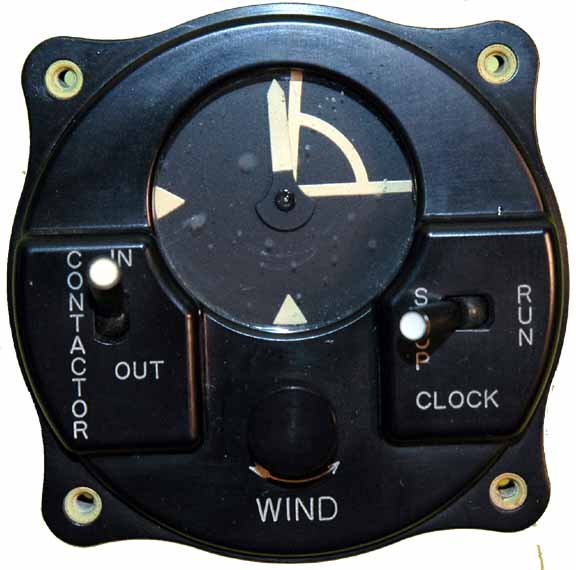 that housed a precision timing device which helped lost pilots find their way. It is also believed that Sangamo continued to repair and service their clocks well into the 1960’s at their Springfield plant.
that housed a precision timing device which helped lost pilots find their way. It is also believed that Sangamo continued to repair and service their clocks well into the 1960’s at their Springfield plant.
The influence that Sangamo had on the clock industry can be found in models by other manufacturers who tried to emulate Sangamo’s electrically wound movements. Electric clocks made by Seth Thomas have been found with nickel plated damasked movements, using a unique winding system, with balance escapement.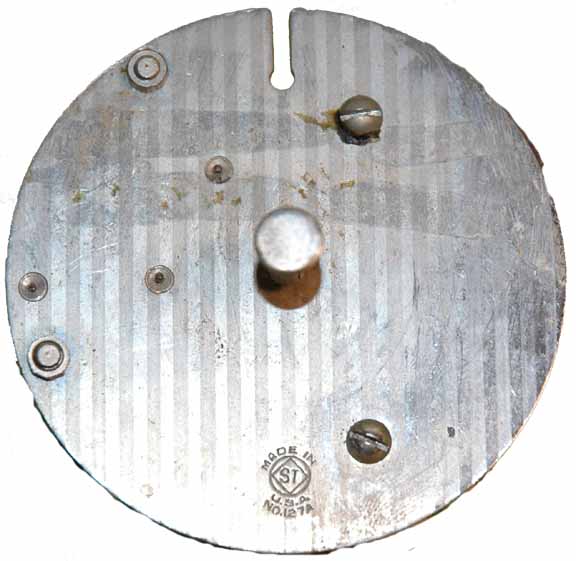 The Imperial Clock Company made a movement that even used an oval 7-jewel Hamilton Platform, but was marked “Imperial.”
The Imperial Clock Company made a movement that even used an oval 7-jewel Hamilton Platform, but was marked “Imperial.” 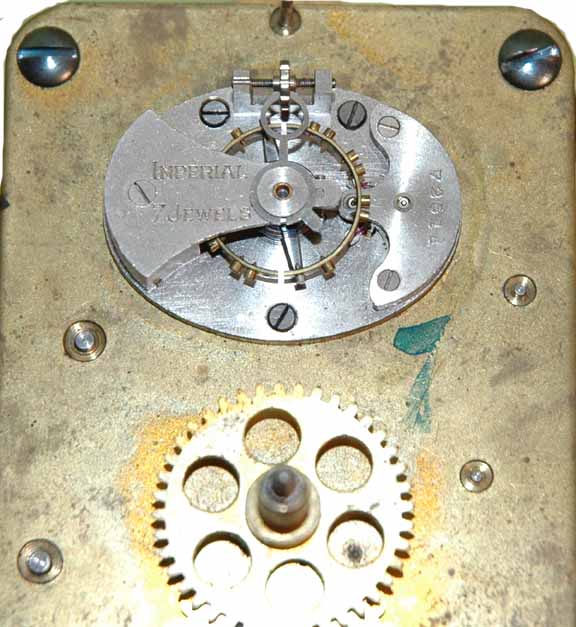 In fact, the old British Sangamo subsidiary of Sangamo is still in business today and their main product is an electric timer.
In fact, the old British Sangamo subsidiary of Sangamo is still in business today and their main product is an electric timer.
For me Sangamo clocks are more than an assembly of parts mass-produced for public consumption. These clocks truly were the “Cadillac” of electric clock production. They represent a place in history where ingenuity, technology, beauty and the pride of American Craftsmanship melded…. if only for a fleeting moment in time.
